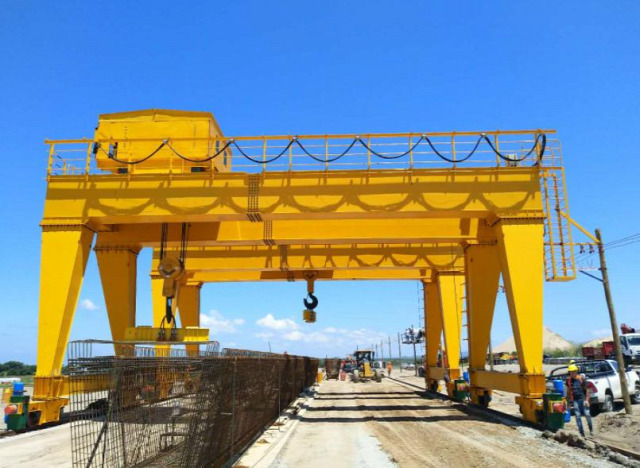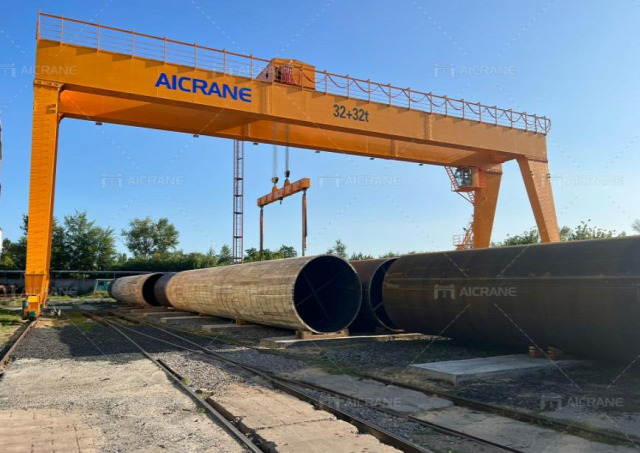Double girder gantry cranes are pivotal in industries where lifting and moving heavy materials are necessary. These cranes are particularly valuable due to their robust construction, substantial load capacity, and ability to handle large spans and heights. However, their performance is significantly influenced by two essential factors: span and lifting height. Understanding the impact of these factors can help operators and decision-makers choose the right crane specifications and optimize crane performance in their specific applications.

1. Understanding Span in Double Girder Gantry Cranes
The span of a gantry crane refers to the horizontal distance between the legs or supporting columns of the crane. In other words, it is the width of the crane’s working area, directly affecting the crane's stability and overall performance. In double girder gantry cranes, the span determines how far the crane can lift and move loads across a workspace.
a. Importance of Span in Crane Selection
The span of a double girder gantry crane should be carefully chosen to align with the operational requirements and physical dimensions of the facility or outdoor area. A well-matched span allows the crane to operate within its optimal performance range, providing efficient load handling across the entire workspace.
A span that is too wide can compromise the stability of the crane, making it susceptible to lateral forces such as wind, particularly in outdoor applications. Conversely, a span that is too narrow may restrict the crane’s operational capacity, preventing it from reaching all areas needed for material handling tasks.
b. Impact of Span on Structural Design
Larger spans require stronger materials and more robust structural design. For instance, a crane with a 30-meter span will need sturdier construction than a crane with a 10-meter span to withstand the additional stress on the beams. This added structural requirement can increase the crane’s overall weight and lead to a higher investment cost.
Moreover, a longer span can cause increased deflection in the girders, potentially leading to issues with load stability and precision during lifting. Therefore, engineering teams often account for span-related deflection by incorporating design modifications such as reinforcing the girders or using high-strength materials.

c. Operational Considerations for Different Span Lengths
Operators must consider the intended usage of the gantry crane when deciding on the span. For example:
- Narrow spans are generally preferred in confined spaces or areas with limited workspace. They are easier to stabilize, cheaper to manufacture, and offer a precise lifting range within smaller areas, such as production lines or warehouses.
- Wider spans are ideal for large industrial sites or yards where the crane needs to move materials across a wide area, such as loading bays, outdoor storage yards, or construction sites. However, these cranes require additional support and stability features to maintain safety and performance.
2. Understanding Lifting Height in Double Girder Gantry Cranes
The lifting height of a gantry crane represents the vertical distance that the crane hook can travel. This height determines how high the crane can lift materials and is a crucial specification for applications that require moving loads to elevated or stacked positions.
a. Importance of Lifting Height in Crane Selection
Selecting the right lifting height depends on the specific requirements of the facility and the nature of the lifting tasks. If the crane’s lifting height is insufficient, it may limit the crane’s functionality and restrict the range of potential applications. On the other hand, choosing an unnecessarily high lifting height can increase the crane’s cost without providing any additional benefit.
For example, a crane used in a shipping yard may need a higher lifting height to stack containers, whereas a crane operating in a low-ceiling warehouse will require a limited lifting height to avoid overhead obstructions.
b. Impact of Lifting Height on Structural Design
A greater lifting height generally requires longer, stronger ropes and pulleys to handle the increased vertical distance. This can lead to an increase in the crane’s overall weight and the need for enhanced motor power to lift loads over greater distances. Additionally, greater lifting heights can impact the crane’s stability, as the load center shifts higher during lifts, making the crane more susceptible to tipping or swaying.
For tall lifting applications, cranes may also be fitted with anti-sway mechanisms and reinforced hoisting systems to ensure stable and safe lifting. These features help minimize load sway, improving precision and reducing the risk of load swinging during lifting and positioning.
c. Operational Considerations for Different Lifting Heights
- Lower lifting heights are commonly used in applications where loads do not need to be raised to high elevations, such as in factories, assembly lines, or warehouses with low ceilings. Lower lifting heights can reduce the mechanical strain on the crane and minimize the overall load on the hoisting mechanism.
- Higher lifting heights are crucial for applications where materials need to be elevated significantly, such as in construction sites, container yards, and large storage facilities. However, higher lifting heights also demand careful consideration of safety protocols and crane operation to prevent accidents.
3. Combined Effects of Span and Lifting Height on Performance
Span and lifting height work together to define the effective working range of a double girder gantry crane. Their combined influence on crane performance can be understood through the following aspects:
a. Load Capacity and Stability
As both span and lifting height increase, the overall load capacity of the crane may need to be adjusted. Long spans and high lifting heights place added stress on the crane’s structure and can compromise stability, particularly when handling heavy loads. Balancing these factors is essential to ensure the crane maintains sufficient load capacity without risking structural failure or instability.
b. Cost Implications
Cranes with larger spans and greater lifting heights often require more robust materials, advanced hoisting systems, and additional safety features. This results in higher costs for both the crane itself and its installation. When selecting a crane, companies need to consider whether the added lifting height or span justifies the extra cost based on their specific operational needs.
c. Precision and Control
Precision in lifting and movement can be more challenging to achieve with increased spans and lifting heights. Higher spans and heights introduce greater potential for load sway and deflection, requiring enhanced control systems to manage the crane’s movement accurately. Modern double girder gantry cranes may be equipped with anti-sway mechanisms, variable frequency drives, and advanced control systems to counteract these issues and ensure smooth operation.
4. Optimizing Performance by Choosing the Right Specifications
To maximize the efficiency of a double girder gantry crane, selecting the right span and lifting height is essential. Key steps include:
- Assessing the workspace dimensions to determine the appropriate span and lifting height.
- Considering the weight and dimensions of typical loads to ensure the crane’s capacity matches the lifting requirements.
- Evaluating environmental factors, such as wind exposure for outdoor cranes or ceiling height for indoor applications, to avoid design conflicts.
- Investing in advanced control features if the crane will be handling delicate or precise positioning tasks.
Conclusion
The span and lifting height of a double girder gantry crane are critical factors that influence its performance, stability, and operational suitability. By carefully evaluating these specifications based on application needs, companies can optimize crane performance, improve safety, and minimize operational costs. Properly chosen span and lifting height ensure that the crane delivers maximum productivity and efficiency across a wide range of industrial applications.

